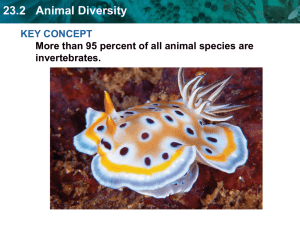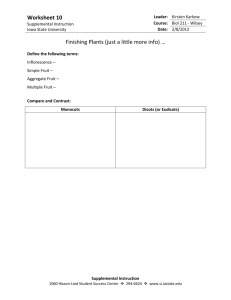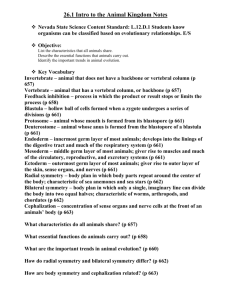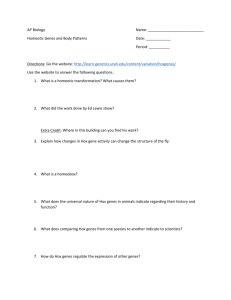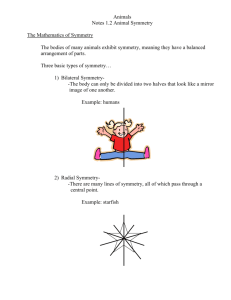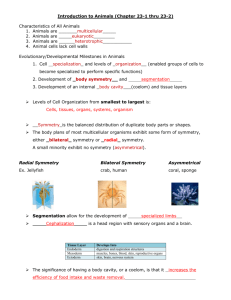General Animal Characteristics (11
advertisement
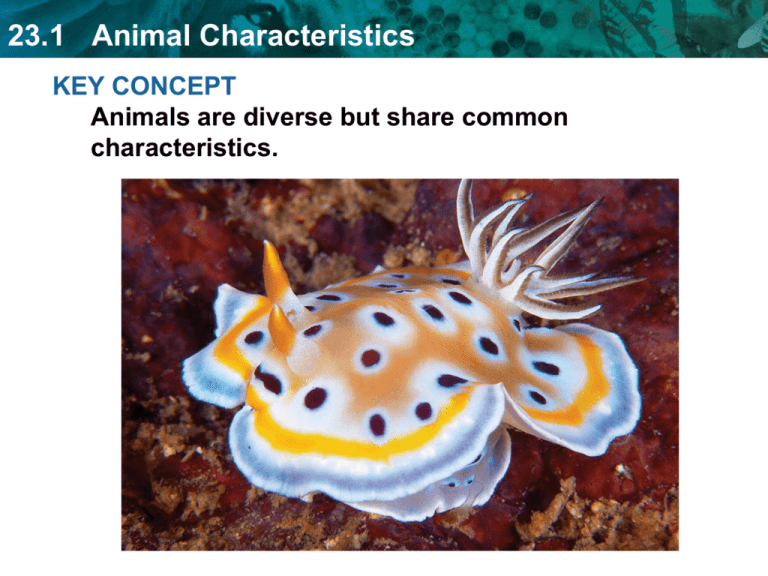
23.1 Animal Characteristics KEY CONCEPT Animals are diverse but share common characteristics. 23.1 Animal Characteristics Animals are the most physically diverse kingdom of organisms. • Animals range in size from 25-meter-long blue whales to microscopic rotifers. • Animals are found nearly everywhere on Earth. 23.1 Animal Characteristics All animals share a set of characteristics. • All animals share a unique set of derived characters. • Animal cells are supported by collagen. – three-stranded protein – found in bone, skin, ligaments, fingernails, and hair 23.1 Animal Characteristics • Animals are diploid and usually reproduce sexually. – diploid parents produce diploid offspring – do not have free-living haploid life stages Diploid cells have two copies of each chromosome: one copy from the mother and one from the father 23.1 Animal Characteristics • Most animals have Hox genes. – Homeotic genes control early development. – Hox genes determine the position of cells differentiation. – A Hox gene mutation leads to the development of a body structure in the wrong position. 23.1 Animal Characteristics • Differences in body plans result from differences in the expression of Hox genes. – Hox genes tell embryonic cells which body part to become. – Mutations in Hox genes led to the vast diversity of animal species. head tail fruit fly genes human HOX-B genes tail head 23.1 Animal Characteristics Each animal phylum has a unique body plan. • Vertebrates have an internal segmented backbone. • Invertebrates do not have a backbone. • Invertebrates encompass most animal groups. 23.1 Animal Characteristics Animals are grouped using a variety of criteria. • Three criteria are used to categorize animals. – body plan symmetry – tissue layers – developmental patterns gastrovascular cavity mouth mesoglea brain muscle hearts blood vessels oral arms mouth segment digestive track nerve cord tentacles 23.1 Animal Characteristics • There are two types of body plan symmetry. – bilateral symmetry: body divides equally along one plane Animals with bilateral symmetry can be divided equally along only one plane, which splits an animal into mirror-image sides. 23.1 Animal Characteristics • There are two types of body plan symmetry. – bilateral symmetry: body divides equally along one plane – radial symmetry: body arranged in circle around a central axis Animals with radial symmetry have body parts arranged in a circle around a central axis. 23.1 Animal Characteristics Types of Symmetry 23.1 Animal Characteristics • Bilateral animals have 3 distinct layers of tissue • Radial animals have only 2 23.1 Animal Characteristics Symmetry Practice 23.1 Animal Characteristics Germ Layer Tissue • Germ layer tissues are aligned in specific positions in an embryo and eventually give rise to all of an animal’s tissues and organs. – Endoderm-inner most layer, develops into the linings of the digestive tract and much of the respiratory system – Mesoderm-middle layer, gives rise to muscles and most internal organs – Ectoderm-outermost layer, gives rise to nervous system and skin • Simpler organisms with radial symmetry only have endoderm and ectoderm. 23.1 Animal Characteristics 23.1 Animal Characteristics Body Cavities • Acoelomates- have no coelom, or body cavity • Pseudocoelomates-have a false or partially lined body cavity with only 1 side being covered with mesoderm • Coelomates-have a true body cavity, both sides of the body cavity are lined with mesoderm 23.1 Animal Characteristics 23.1 Animal Characteristics Gastrulation • Gastrulation is an interior movement of cells that results in a reorganization of the embryo from a simple spherical ball of cells, the blastula, into a multi-layered organism. Two types: – Protostomes form mouth-first, and anus second. – Deuterostomes first form the anus and then the mouth. 23.1 Animal Characteristics A comparison of structure and genetics reveals the evolutionary history of animals. • Protostomes and deuterostomes are the two major radiations on the animal phylogenetic tree. NO TISSUES RADIAL lancelets, vertebrates sea stars, sea urchins crustaceans, insects, spiders Echinodermata Nematoda Arthropoda Chordata roundworms clams, snails, octopuses Segmented worms flatworms Cnidaria Platyhelminthes Annelida Mollusca jellyfish, coral, anemones sponges Porifera DUETEROSTOMES PROTOSTOMES 23.1 Animal Characteristics • The current organization of the animal kingdom shows some unexpected relationships. • Technological advancements help to clarify evolutionary relationships.
